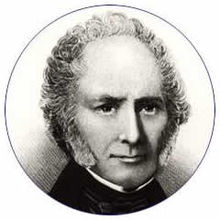- William Sturgeon
-
William Sturgeon (* 22. Mai 1783 in Whittington, Lancashire; † 4. Dezember 1850 in Prestwich) war ein englischer Physiker und Erfinder, der die ersten Elektromagnete herstellte.
 Der erste künstliche Elektromagnet, von Sturgeon im Jahre 1824 erfunden. Zeichnung Sturgeons aus seinem Paper für die British Royal Society of Arts, Manufactures, and Commerce von 1824. Der Magnet bestand aus 18 Windungen nackten Kupferdrahtes (isolierter Draht war noch nicht erfunden)[1]
Der erste künstliche Elektromagnet, von Sturgeon im Jahre 1824 erfunden. Zeichnung Sturgeons aus seinem Paper für die British Royal Society of Arts, Manufactures, and Commerce von 1824. Der Magnet bestand aus 18 Windungen nackten Kupferdrahtes (isolierter Draht war noch nicht erfunden)[1]
Leben
Sturgeon wurde in Whittington (Lancashire) geboren und ging bei einem Schuhmacher in die Lehre. Er trat der Armee 1802 bei und lernte im Selbststudium Mathematik und Physik. 1824 wurde er Dozent am Royal Military College in Addiscombe (Surrey); im folgenden Jahr stellte er seinen ersten Elektromagneten vor.
1832 wurde er von der Adelaide Gallery of Practical Science eingestellt. 1836 gründete er die Annals of Electricity, und im gleichen Jahr erfand er ein Galvanometer.
1840 wurde er Superintendent der Royal Victoria Gallery of Practical Science in Manchester, die 1842 geschlossen wurde. Er starb am 4. Dezember 1850 in Prestwich.
Weblinks
- Adventures in CyberSound: Sturgeon, William. Biografie (englisch)
Einzelnachweise
- ↑ Sylvanus P. Thompson: Lectures on the Electromagnet. W.J. Johnson Co., New York 1891, S. 17-19
Wikimedia Foundation.

